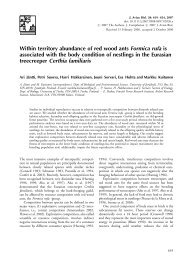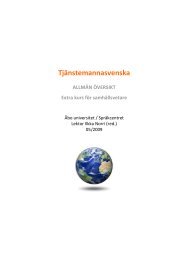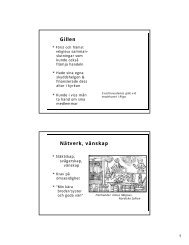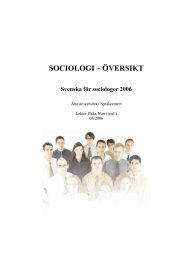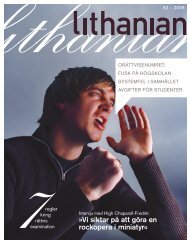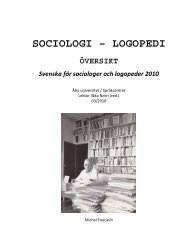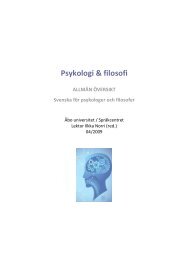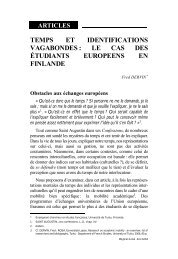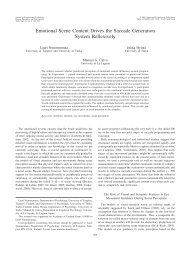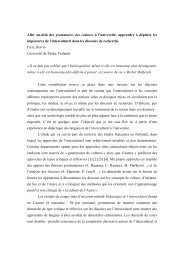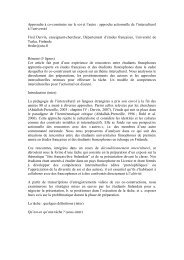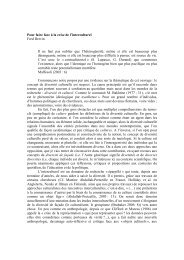Towards a Trope Nominalist Theory of Natural Kinds Nominalism: A ...
Towards a Trope Nominalist Theory of Natural Kinds Nominalism: A ...
Towards a Trope Nominalist Theory of Natural Kinds Nominalism: A ...
Create successful ePaper yourself
Turn your PDF publications into a flip-book with our unique Google optimized e-Paper software.
<strong>Towards</strong> a <strong>Trope</strong> <strong>Nominalist</strong><br />
<strong>Theory</strong> <strong>of</strong> <strong>Natural</strong> <strong>Kinds</strong><br />
<strong>Nominalism</strong>: A Reassessment, University <strong>of</strong> Geneva 18/9 2012<br />
Dr Markku Keinänen<br />
University <strong>of</strong> Turku
Introduction<br />
• My aim is present the beginnings <strong>of</strong> a trope nominalist<br />
theory <strong>of</strong> natural kinds.<br />
• Its principal rivals are Neo-Aristotelian (Lowe 1998;<br />
Ellis 2001) and Reductive Realist (Hawley & Bird 2011)<br />
theories.<br />
• The theory is trope nominalist (all entities are<br />
particulars). The only fundamental categories are<br />
property and relation tropes.<br />
• It denies the existence <strong>of</strong> natural kinds as separate<br />
entities. <strong>Natural</strong> kinds are not identified with anything<br />
in the mind-independent reality.<br />
• It identifies natural kinds with natural kind terms with<br />
certain application conditions.
<strong>Trope</strong>s<br />
<strong>Trope</strong>s are fundamental concrete (spatiotemporal)<br />
particulars. They have the following category features.<br />
1.Particular: tropes exist in a single location.<br />
2.Determinate identity conditions: it is determinate<br />
whether or not trope t is identical with some entity e.<br />
3.Countable: it is determinate how many tropes there are<br />
in some location.<br />
4.Categorially simple: all parts <strong>of</strong> tropes are further<br />
tropes.
<strong>Trope</strong>s<br />
5. Identity independent existents: a trope has<br />
determinate identity conditions independently <strong>of</strong> the<br />
identity any other entity (substance, spacetime point).<br />
<strong>Trope</strong>s are particular properties: entities with the<br />
above five category features and a thin particular<br />
nature:<br />
• Thin nature: a trope has a thin particular nature to<br />
determine a single feature <strong>of</strong> the object possessing the<br />
trope (e.g., -e charge <strong>of</strong> an electron).
<strong>Trope</strong>s<br />
●<br />
●<br />
●<br />
Moreover, all trope theories assume that trope t can<br />
exist spatiotemporally co-located with the other<br />
tropes.<br />
The different trope theories (trope bundle theories <strong>of</strong><br />
substance) construct objects (or, substances) as<br />
aggregates <strong>of</strong> tropes that fulfil certain conditions but<br />
differ in the conditions that property tropes must fulfil.<br />
According to independence theorists (Williams 1953;<br />
Campbell 1990), objects are mereological sums <strong>of</strong><br />
mutually spatiotemporally co-located (compresent)<br />
tropes.
The SNT<br />
• The SNT (Strong Nuclear <strong>Theory</strong>) constructs simple<br />
substances as aggregates <strong>of</strong> tropes connected by rigid<br />
dependence.<br />
o Nuclear tropes <strong>of</strong> substance i are either single<br />
trope t, or two or several tropes t 1<br />
, ..., t n<br />
rigidly<br />
dependent on each other.<br />
o If there are more than one nuclear tropes, they are<br />
"qualitatively diverse": they fall under distinct<br />
determinables.<br />
o <strong>Trope</strong> t is a part <strong>of</strong> substance i iff t is rigidly<br />
dependent only on the nuclear tropes <strong>of</strong> i.
Determinate and Determinable<br />
kinds <strong>of</strong> tropes<br />
• According to the SNT, all tropes are properties <strong>of</strong> some<br />
basic physical quantity (mass, electric charge, etc.)<br />
•<br />
Quantity tropes falling under some determinable D are<br />
all mutually connected by:<br />
a. By some relation <strong>of</strong> (positive or negative)<br />
proportion (such as 2 : 1 - proportion)<br />
b. By the relation <strong>of</strong> order (equal or greater than).<br />
•<br />
The tropes falling under a single determinable (e.g.,<br />
all mass tropes) are all connected by some relation <strong>of</strong><br />
proportion, while the tropes falling under distinct<br />
determinables (mass and charge tropes) are not.<br />
•<br />
<strong>Trope</strong>s fall under a single determinable because they<br />
are all connected by some relation <strong>of</strong> proportion.
Determinate and Determinable<br />
kinds <strong>of</strong> tropes<br />
• The relations <strong>of</strong> proportion (and order) are formal<br />
relations:<br />
o they can (in principle) connect any kind <strong>of</strong> entity.<br />
o the existence <strong>of</strong> an entity presupposes that its<br />
place in the network <strong>of</strong> formal relations is fixed.<br />
o they are ungrounded internal relations: given that<br />
-e trope trope t 1<br />
and -e/3 trope t 2<br />
exist, they are in<br />
the relation <strong>of</strong> 3 : 1 proportion to each other.<br />
o<br />
they allow <strong>of</strong> an operational characterization (cf.<br />
Smith & Mulligan 1983).
Determinate and Determinable<br />
kinds <strong>of</strong> tropes<br />
• According to many standard presentations, the trope theory<br />
claims that "property universals" are classes <strong>of</strong> exactly<br />
similar tropes. This has two possible interpretations:<br />
a. universals are sets <strong>of</strong> tropes (abstract individuals)<br />
b. universals are pluralities <strong>of</strong> tropes<br />
• I reject both <strong>of</strong> these accounts:<br />
a. for the reasons <strong>of</strong> economy, it is reasonable to avoid the<br />
postulation <strong>of</strong> sets.<br />
b. we cannot identify a universal, which is one (or, a<br />
unity), with a plurality. Pace WIlliams' (1986) painless<br />
realism, we cannot coherently consider a plurality <strong>of</strong><br />
tropes as one, i.e., a universal.
Determinate and Determinable<br />
kinds <strong>of</strong> tropes<br />
• Moreover, determinate and determinable kinds are<br />
natural kinds <strong>of</strong> tropes. <strong>Trope</strong>s are instances <strong>of</strong><br />
determinate and determinable kinds: e.g., 1 kg trope t<br />
is an instance <strong>of</strong> the determinable kind mass (the kind<br />
<strong>of</strong> mass tropes).<br />
• Prima facie, determinate and determinable kinds are<br />
distinct from their instances and they could have<br />
different numbers <strong>of</strong> instances.
Determinate and determinable<br />
kinds <strong>of</strong> tropes<br />
• I suggest to identify determinate and determinable<br />
kinds with kind terms having certain determinate<br />
application conditions:<br />
o for instance, the kind <strong>of</strong> 1 kg tropes is an<br />
abstractum from the kind terms exactly applying to<br />
a group <strong>of</strong> tropes in the relation <strong>of</strong> 1 : 1 proportion<br />
to each other.<br />
o the determinable kind <strong>of</strong> mass tropes is an<br />
abstractum from the kind terms exactly applying to<br />
a group <strong>of</strong> tropes mutually connected by some<br />
relation <strong>of</strong> proportion and the relation <strong>of</strong> order.
Determinate and Determinable<br />
kinds <strong>of</strong> tropes<br />
• The talk about a "kind term" can refer:<br />
a. to a type <strong>of</strong> interpreted tokens<br />
b. to any token <strong>of</strong> that type: any kind term token with<br />
certain determinate application conditions<br />
•<br />
Here, I identify determinable and determinate kinds<br />
with abstracta the from kind terms in the sense <strong>of</strong> b.<br />
•<br />
For instance, the kind <strong>of</strong> mass tropes is an abstractum<br />
from a group <strong>of</strong> kind terms exactly applying to a group<br />
<strong>of</strong> tropes mutually connected by the some formal<br />
relation <strong>of</strong> proportion and the relation <strong>of</strong> order.<br />
•<br />
A determinable/determinate kind is an abstractum<br />
from a plurality, not itself a unity (it is not a universal<br />
or a proxy universal).
Determinable kinds and<br />
truthmaking<br />
• The determinable kind term is a mass trope exactly<br />
applies to the tropes in some relation <strong>of</strong> proportion<br />
and in the relation <strong>of</strong> order to any particular mass<br />
trope.<br />
• Mass trope t is the truthmaker <strong>of</strong> claim A:<br />
A. t is a mass trope.<br />
• <strong>Trope</strong> t has a thin particular nature (e.g., it is a 1 kg<br />
trope). Because <strong>of</strong> its nature, t is in some formal<br />
relation <strong>of</strong> proportion and the relation <strong>of</strong> order to any<br />
other mass trope. Claim A is is true because t exists.
Determinate kinds and truthmaking<br />
• The determinate kind term is a 1 kg trope exactly<br />
applies to the tropes in the relation 1 : 1 proportion<br />
and in the relation <strong>of</strong> equal in order to any 1 kg trope.<br />
• 1 kg trope t is the sole truthmaker <strong>of</strong> claim B:<br />
B. t is a 1 kg trope.<br />
●<br />
<strong>Trope</strong> t has a thin particular nature <strong>of</strong> a 1 kg trope.<br />
Because <strong>of</strong> its nature, t is in the formal relation <strong>of</strong> 1 :<br />
1 proportion and in the relation <strong>of</strong> equality to any<br />
other 1 kg trope. Claim B is true because t exists.
<strong>Natural</strong> kinds <strong>of</strong> substances<br />
• Since trope theory identifies substances with trope<br />
bundles, natural kinds <strong>of</strong> substances (substantial<br />
natural kinds) are more difficult case for a trope<br />
theorist.<br />
•<br />
Objects divide into natural kinds and the division is<br />
ubiquitous:<br />
o natural kinds <strong>of</strong> fundamental micro-particles<br />
(leptons, quarks, bosons)<br />
o<br />
o<br />
natural kinds <strong>of</strong> complex objects studied by physics<br />
and chemistry (atoms, chemical compounds)<br />
natural kinds <strong>of</strong> still more complex objects (living<br />
organisms, complex natural objects)
<strong>Natural</strong> kinds <strong>of</strong> substances<br />
• The members <strong>of</strong> a natural kind are usually similar in<br />
various distinct respects and behave in similar ways in<br />
the same kind <strong>of</strong> circumstances.
<strong>Natural</strong> kinds <strong>of</strong> substances<br />
The following functions are assigned to natural kinds:<br />
1.[Semantic theory]: <strong>Natural</strong> kinds are referents <strong>of</strong><br />
natural kind terms (cf., e.g., Lowe 2009).<br />
2.[Metaphysics <strong>of</strong> science]: <strong>Natural</strong> kinds instantiate the<br />
basic dispositional properties and the fundamental laws<br />
<strong>of</strong> nature are true <strong>of</strong> each member <strong>of</strong> some kind K (Ellis<br />
2001; Lowe 2009).<br />
3.[Neo-Aristotelian essentialism]: Every substance<br />
necessarily belongs to some (sufficiently general)<br />
natural kind, which determines its identity conditions<br />
and rules out bare particulars (Loux 1978; Lowe 1998,<br />
2009).
Perfectly and less than perfectly<br />
natural kinds<br />
• It is instructive to distinguish between perfectly and<br />
less than perfectly natural kinds (i.e., the naturalness<br />
<strong>of</strong> kinds admits <strong>of</strong> degrees).<br />
•<br />
Perfectly natural kinds must satisfy a set <strong>of</strong> constraints<br />
(cf. Ellis 2001: 21-23):<br />
o [E1]: they have determinate boundaries: it is<br />
determinate whether object i is member <strong>of</strong> kind K.<br />
o<br />
o<br />
[E2]: members <strong>of</strong> a natural kind K share a set <strong>of</strong><br />
intrinsic features, and the members <strong>of</strong> distinct<br />
kinds have distinct intrinsic features.<br />
[E3]: natural kind K has a kind essence: a set <strong>of</strong><br />
intrinsic features necessary to every member <strong>of</strong> K.
Perfectly and less than perfectly<br />
natural kinds<br />
• <strong>Natural</strong> kinds <strong>of</strong> fundamental micro-particles and <strong>of</strong> some<br />
complex objects studied physics and chemistry (e.g.,<br />
electron, d-quark, helium atom, water molecule) are prima<br />
facie examples <strong>of</strong> perfectly natural kinds.<br />
• The kinds <strong>of</strong> organisms (i.e., biological species e.g., polar<br />
bear), and also kinds <strong>of</strong> some chemical compounds are not<br />
perfectly natural.<br />
• Prima facie, the perfectly natural kinds fit roles 2 and 3<br />
assigned to kinds. By contrast, role 1 seems to require a<br />
more liberal conception <strong>of</strong> kinds. A part <strong>of</strong> the motivation <strong>of</strong><br />
the more liberal conceptions is to clarify the role <strong>of</strong><br />
scientific kinds in scientific explanation and as referents <strong>of</strong><br />
kind terms (cf. Boyd 1999, 2010).
A trope nominalist theory <strong>of</strong><br />
substantial kinds<br />
• I suggest "a bottom up approach" based on the SNT.<br />
First, we account for natural kinds <strong>of</strong> simple<br />
substances. The second step is to generalize the theory<br />
to the other perfectly natural kinds (i.e., kinds <strong>of</strong><br />
complex substances). Finally, we take up less than<br />
perfectly natural kinds.<br />
• In each step, we identify natural kinds with kind terms<br />
with certain application conditions.<br />
• However, the application conditions <strong>of</strong> kind terms<br />
differ in different steps.<br />
• Only in the first step (the kinds <strong>of</strong> simple substances),<br />
we make a direct reference to tropes.
<strong>Natural</strong> kinds <strong>of</strong> simple substances<br />
• According to the SNT, simple substances are trope<br />
bundles with nuclear tropes:<br />
o every simple substance has one nuclear trope or<br />
two or more nuclear tropes rigidly dependent on<br />
each other.<br />
o<br />
o<br />
nuclear trope t belongs to determinate kind D<br />
because t is in the relation <strong>of</strong> 1 : 1 proportion to<br />
every D-trope.<br />
if there are several nuclear tropes, they are in the<br />
relations proportion to the tropes falling under<br />
distinct determinables, i.e., fall under distinct<br />
determinables themselves.
<strong>Natural</strong> kinds <strong>of</strong> simple substances<br />
• Let us call natural natural K necessary to substance i<br />
the primary kind <strong>of</strong> i.<br />
• I suggest to identify natural kinds <strong>of</strong> simple substances<br />
with abstracta from the kind terms applying to<br />
substances.<br />
• Substance i belongs to primary kind K (e.g., electron)<br />
iff there is a group <strong>of</strong> kind terms with certain<br />
determinate application conditions and any kind tem K<br />
belonging to that group applies to i.<br />
• The application conditions <strong>of</strong> the kind term <strong>of</strong> a<br />
primary kind K can be specified as follows:
<strong>Natural</strong> kinds <strong>of</strong> simple substances<br />
[P1]: Kind term K applies to any simple substance i that<br />
satisfies the following two conditions:<br />
a. substance i has nuclear tropes t 1<br />
,...,t n<br />
.<br />
b. tropes t 1<br />
,...,t n<br />
belong to determinate kinds<br />
D 1<br />
,...,D n<br />
.<br />
[P2]: <strong>Trope</strong>s t 1<br />
,...,t n<br />
satisfy condition b because they are<br />
the tropes they are. Their existence is also sufficient for<br />
the existence substance i. Consequently, tropes t 1<br />
,...,t n<br />
make jointly true the claim that i belongs to kind K.
<strong>Natural</strong> kinds <strong>of</strong> simple substances<br />
• Condition [P1] lays down the application conditions <strong>of</strong><br />
a natural kind term <strong>of</strong> primary kind K.<br />
o clause [a] claims that certain tropes are naturally<br />
unified by being mutually rigidly dependent. They<br />
determine the necessary features <strong>of</strong> a member <strong>of</strong> K<br />
(the kind essence <strong>of</strong> K).<br />
o<br />
•<br />
in this case, kind essence <strong>of</strong> K is also necessary to i<br />
(K is a primary kind).<br />
It is easy to check that the nuclear tropes <strong>of</strong><br />
substance i are truthmakers <strong>of</strong> the claim that i belongs<br />
to kind K ([P2]).
<strong>Natural</strong> kinds <strong>of</strong> simple substances<br />
• By modifying clause [P1a], we can formulate application<br />
conditions <strong>of</strong> the kind terms <strong>of</strong> other perfectly natural kinds<br />
than just primary kinds.<br />
• For instance, some natural kind K might be contingent to its<br />
members. Still, it has a kind essence (it satisfies [E3]). In<br />
such case, the tropes that make substance i member <strong>of</strong> K<br />
are its nuclear tropes and some mutually rigidly dependent<br />
tropes contingent to i.<br />
• By modifying clause [P1b], we obtain natural kinds which<br />
are not perfectly natural but still have determinate<br />
boundaries (fulfil [E1]): for instance, one might suggest that<br />
due to nuclear tropes that belong to certain determinate<br />
and determinable kinds, substance i is <strong>of</strong> kind K' (e.g., is a<br />
lepton).
Generalisation to complex<br />
substances<br />
• The present approach can be generalized to the<br />
perfectly natural kinds <strong>of</strong> complex substances. [C1]<br />
illustrates how that might happen:<br />
[C1]: Kind term K applies to any complex substance i that<br />
satisfies the following three conditions:<br />
a. substance i has substances i 1<br />
,...,i n<br />
as its proper parts.<br />
b. substances i 1<br />
,...,i n<br />
belong to natural kinds K 1<br />
,...,K n<br />
.<br />
c. i 1<br />
,...,i n<br />
are naturally unified due to their relative<br />
spatial locations and causal powers.
Generalisation to complex<br />
substances<br />
• The basic idea <strong>of</strong> [C1] is: we start with simple (or. simpler)<br />
substances belonging to certain natural kinds that compose<br />
complex substance i.<br />
• Conversely, substance i belongs to kind K because it has<br />
certain kinds substances as its essential/kind essential<br />
proper parts.<br />
• Tentative examples: neutrons, protons, different kinds <strong>of</strong><br />
atoms.<br />
• The natural unification condition [C1c] is crucial and would<br />
deserve more discussion. An adequate formulation <strong>of</strong> the<br />
condition would give a partial anwers to van Inwagen's<br />
(1990) special composition question.
Conclusion<br />
• The present theory denies the existence <strong>of</strong> natural kinds as<br />
constituents <strong>of</strong> the mind-independent reality. They are<br />
identified with kind terms having certain determinate<br />
application conditions.<br />
• However, the truthmakers <strong>of</strong> the attributions <strong>of</strong> perfectly<br />
natural kinds are independent <strong>of</strong> us.<br />
• It builds on the SNT and on the assumption that there are<br />
simple substances that divide into natural kinds with a set<br />
<strong>of</strong> intrinsic properties essential to each kind K.<br />
• Unlike reductive realist theory <strong>of</strong> Hawley & Bird (2011), it<br />
does not introduce complex properties or causal proceses<br />
binding properties. All entities bound by processes are<br />
already trope bundles (substances).
References<br />
Boyd, R. (1999): “Homeostasis, Species and Higher Taxa”, In Robert Wilson (ed.): Species: New<br />
Interdisciplinary Essays, (London: The MIT Press).<br />
Boyd, R. (2010): “ Realism, <strong>Natural</strong> <strong>Kinds</strong>, and Philosophical Methods”, in Beebee, H. &<br />
Sabbarton-Leary, Metaphysics and Semantics <strong>of</strong> <strong>Natural</strong> <strong>Kinds</strong> (London: Routledge), 212-234.<br />
Campbell, K. K. (1990): Abstract Particulars. (Oxford: Basil Blackwell)..<br />
Ellis, B. (2001): Scientific Essentialism, (Cambridge: Cambridge University Press).<br />
Hawley, K. & Bird, A. (2011): “What are <strong>Natural</strong> <strong>Kinds</strong>”, Philosophical Perspectives 25, 205-221.<br />
Keinänen, M. (2011): “<strong>Trope</strong>s – the Basic Constituents <strong>of</strong> Powerful Particulars?”, Dialectica 65: 3,<br />
419-450.<br />
Lowe, E. J. (1998): The Possibility <strong>of</strong> Metaphysics - Substance, Identity and Time, (Oxford:<br />
Clarendon Press).<br />
Lowe, E. J. (2009): More <strong>Kinds</strong> <strong>of</strong> Being, (Oxford: Wiley-Blackwell).<br />
van Inwagen, P. (1990): Material Beings, (Ithaca: Cornell University Press.<br />
Williams, D. C. (1953a): “On the Elements <strong>of</strong> Being I”, Review <strong>of</strong> Metaphysics 7, 3-18.<br />
Williams, D. C. (1986): “Universals and Existents”, Australasian Journal <strong>of</strong> Philosophy 64, 1, 1-18



